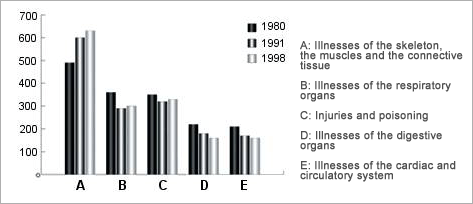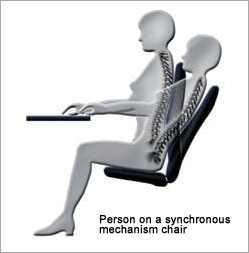MOVE IN NATURE
IS A HUMAN BEING BORN TO SIT?
DO OFFICE CHAIRS FOLLOW NATURAL SEATING BEHAVIOUR?

Sickness days per 100 compulsorily insured members (Source: Industrial Healthy Insurance sickness statistics)
Illnesses of the skeleton, the muscles and the connective tissue increased dramatically between 1980 and 1998. In the same period days lost due to other illnesses were able to be reduced because of medical advances (see illustration).

IS THIS HEALTHY?
The length of time spent sitting by "modern" office staff is one of the main causes of illness-related industrial absences.
Since sitting in itself is not unnatural, the cause of industrial absences must be looked for in the prevaling seating postures.
Evidently we have not made any progress in the area of sitting.
MOTION NEEDS FREEDOM
"Sit up straight" This has certainly been heard often enough and this is how chairs were designed too. A single rigid shape, which is intended to keep the body upright. Several decades ago ergonomists first identified movement as benefical.
Natural seating however was at this time not a focus of attention. True, there had been advences, and chairs are being built which can move, but the natural movement process of the human being is still not integrated into the office chair.
Anyone who wants to sit comfortably will change his sitting position and the shape of his back! Hitherto, however, this movement process has been not supported, but restricted, because conventional office chairs follow a philosphy that only allows sitting with an unaltered straight back posture. This thinking came from the assumption that standing is better for the spinal column than sitting. Thus, when sitting was necessary, then at the least it had to be with a straight posture.
NATURAL MOVEMENTS OF THE SPINE
Sitting is quite simple. Just like running, standing or lying down. To think about it seems pointless because normally we simply follow our nature and just sit down. Anyone who sits naturally, sits well, and anyone who trusts his instincts actually does everything right.
This however sounds easier than it often is in reality, because civilisation has made us inflaxible by nature, and the only seating postures on offer are "upright" and "straight". Thus every natural movement has been lost.
MOTION
What could be more obvious than to follow natural instincts?
Movement and alternating seating postures are necessary to remain healthy - particularly when sitting in the office from day to day. But natural seating can only be guarenteed by chairs that do not regiment to user. The reality today however is that office chairs unfortunely do precisely this. They regiment us!
People have to submit to the shape and the mechanism of conventional office chairs. The chair regulates movement, the person follows. Technology rules people. Actually, it should be exactly the opposite.
- How offen when sitting do we brace ourselves against the sprung backrest? Force is met with counter-force.
- How offen do we lean back and feel the rigid lordosis support as an unpleasant pressure on the back?
- How offen do we want to move and lean back whilst working, but are not able to because we would then lose contact with the work surface.
- How offen do we lean back to relax, but have to bend our head forwards uncomfortably so that we can still see the person sitting oposite?
- Is it healthy? Is it comfortable?